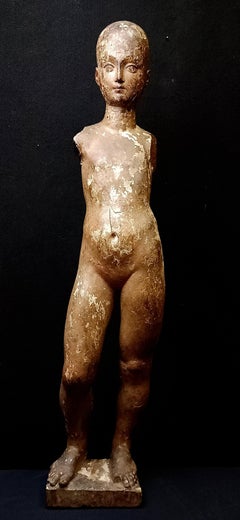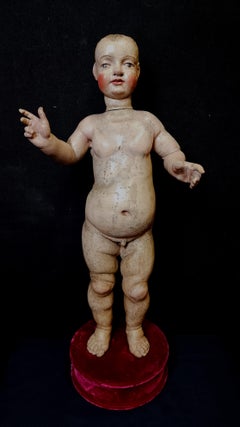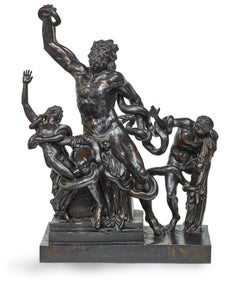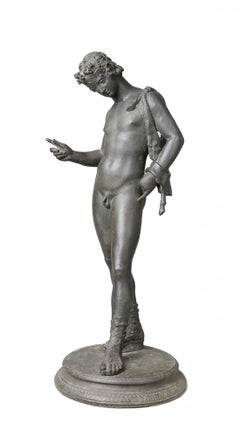Aliprandi Antichità di Cristina Aliprandi Nude Sculptures
to
1
1
Overall Width
to
Overall Height
to
2
2
2
2
1
1
1
1
1
2
2
FIGURE OF A CHILD - Sculpture ligneous
Located in Milano, IT
Elegant 15th-century wooden sculpture of a finely executed infant missing his arms. The work, of central Italian provenance, recalls the Donatello manner in the delicacy of the featu...
Category
15th Century and Earlier Italian School Nude Sculptures
Materials
Wood
Bambin Gesù Benediciente - Polychrome Sculpture
Located in Milano, IT
Splendid polychrome wooden sculpture depicting the Blessing Child Jesus, made by a Central Italian master in the 14th century. The work, 66 cm high, is distinguished by its harmoniou...
Category
15th Century and Earlier Italian School Nude Sculptures
Materials
Wood
Related Items
Laocoön and his Sons, an exceptional bronze sculpture by Giacomo Zoffoli
Located in PARIS, FR
This exceptional bronze group (unpublished), executed in Rome in the second half of the 18th century, bears witness to the fascination with the Laocoön since its discovery on January...
Category
1770s Italian School Nude Sculptures
Materials
Bronze
$79,205
H 10.13 in W 14.82 in D 6.5 in
Grand Tour Bronze Sculpture of Dionysus, 19th Century Italian School
Located in Beachwood, OH
19th Century Italian School
Grand Tour Bronze Sculpture of Dionysus, 19th Century
Bronze with black-green patination
24 x 10 x 10 inches
Dionysus, in Greco-Roman religion, a nature ...
Category
19th Century Italian School Figurative Sculptures
Materials
Bronze
Colonial West African Baule Baoule Figure Sculpture Woman wearing loincloth
Located in Norwich, GB
An elegant African sculpture from the West African Baoulé or Baule people, depicting a young woman wearing a loincloth. Smooth black lightly worn patina.
Category
Mid-20th Century Tribal Figurative Sculptures
Materials
Wood
$760
H 17.33 in W 2.76 in D 3.55 in
Frine (Phryne), 19th Century Large Marble Sculpture of Nude Woman
Located in Beachwood, OH
Ercole Rosa (Italian, 1846 - 1893)
Frine (Phryne)
Marble
Signed 'E. Rosa, Studio O. Andreoni, Roma' on back
34.5 x 12 x 10 inches
80 lb.
Phryne was a 4th century BC famous Greek ...
Category
19th Century Italian School Figurative Sculptures
Materials
Marble
$35,000
H 34.5 in W 12 in D 10 in
Large Mahogany Relief of Prometheus, The Giver of Fire in Style of Peterpaul Ott
Located in Soquel, CA
Large Scale Mahogany Wood Relief Sculpture of Prometheus, The Giver of Fire In the Style of WPA artist Peterpaul Ott
Wonderfully executed wood r...
Category
1950s Other Art Style Figurative Sculptures
Materials
Wood, Mahogany
$6,112 Sale Price
20% Off
H 50.5 in W 44 in D 2 in
"Putti" 19th c. Terracotta, Antique, Mythical Figures, Patina
Located in Detroit, MI
“Putti” is a 19th c. terracotta antique of two nude children, babies, as mythical figures. This piece is beautifully rendered with a rich brown patina. ...
Category
Late 19th Century Baroque Nude Sculptures
Materials
Terracotta, Wood
$9,500
H 12 in W 17 in D 7 in
Male Classical Torso
By Larry Scaturro
Located in Brooklyn, NY
Male classical torso.
Category
2010s Contemporary Figurative Sculptures
Materials
Wood, Walnut
Musidora
Located in PARIS, FR
"Musidora"
by Odoardo FANTACCHIOTTI (1809-1877)
Sculpture made in white Carrara marble
signed on the side on the base " O. Fantacchiotti "
Italy
around 1862
height 110 cm
diameter ...
Category
1860s Italian School Nude Sculptures
Materials
Marble
NYDIA, THE BLIND FLOWER GIRL OF POMPEII Marble Sculpture 1856-1870
Located in Soquel, CA
Randolph John Rogers (American, 1825 - 1892) Randolph Rogers' Nydia, the Blind Flower Girl of Pompeii debuted in 1856 to critical and public acclaim, solidifying Rogers’ position as a pre-eminent American sculptor and it remains one of the artist’s most celebrated works today. The subject of Nydia is drawn from Edward Bulwer-Lytton's The Last Days of Pompeii 1834. After touring the ruins of the ancient city in 1833, and inspired by the stories of blinding volcanic ash, he composed the tale of Nydia, a slave who led her master, Glaucus, to safety. Rogers depicts Nydia at the moment that she and Glaucus have become separated in their perilous journey through the rubble and Nydia seeks familiarity in the surrounding chaos, her distress evident in her pained expression. The grace of the sculpture is at odds with the turmoil portrayed; a toppled Corinthian capital lies at her feet and obstructs her next step, indicated by the tilt of her back foot and grip on her walking stick. Examples of this model can be found in major American collections, including The Metropolitan Museum of Art, the Art Institute of Chicago, the Detroit Institute of Arts, the Los Angeles County Museum of Art, and the Museum of Fine Arts, Boston.
Literature, Millard F Rogers, Jr. Randolph Rogers, American Sculptor in Rome. University of Massachusetts Press, 1971, American Figurative Sculpture in the Museum of Fine Arts Boston. Museum of Fine Arts, Boston, 1986. Joyce K Schiller. "Nydia, A Forgotten Icon of the Nineteenth Century." Bulletin of the Detroit Institute of Arts,
Born in Waterloo, New York, Randolph John Rogers became an expatriate* sculptor of idealized figures, portraits, and commemorative works in Neo-Classical* and Realist* styles. He worked in clay, plaster, marble and bronze, and lived both in Italy and the United States. He made 167 examples of Nydia in two sizes (varies depending on base height) 36" and 54'.
Rogers was raised in Ann Arbor, Michigan, and as a young man did woodcuts* for the local newspaper, The Michigan Argus, and also worked as a baker's assistant and a dry goods clerk. In 1847, he moved to New York City, where he hoped to find work as an engraver*, but failing to do so, worked in a dry goods store owned by John Steward...
Category
1850s Italian School Figurative Sculptures
Materials
Marble
$12,000 Sale Price
20% Off
H 36 in W 19 in D 20 in
Putto in legno dorato reggi candela barocco italiano
Located in Florence, IT
One flame candle holder putto made of gilded wood.
Those kind of objects were present in churches or noble villas, specially during the Baroque times.
The base is not coeval.
Category
17th Century Baroque Nude Sculptures
Materials
Gold
$8,132
H 47.25 in W 15.75 in
Standing Female Nude After Alexander Archipenko
By Walt Kuhn
Located in Fairlawn, OH
Illustrated: "Walt Kuhn, Painter, His Life and Work, by Phillip Rhys Adams, page 67, plate 27, Courtesy of Kennedy Galleries-Kuhn Estate (see photo)
Kuhn’s sculptures were collected...
Category
1910s Cubist Figurative Sculptures
Materials
Wood
$25,000
H 12.5 in W 3.75 in D 3.5 in
Places In The Heart, Nut wood sculpture on steel base, female nude, brown
By Troy Williams
Located in Santa Fe, NM
Places In The Heart, Nut wood sculpture on steel base, female nude, brown, Williams
Sculptor Troy Williams unites the timeless and the contemporary in sculptures of rare beauty and meaning Beyond all the narrative potential of the three obvious physical dimensions of Troy Williams’ sculpture, there are many other considerations that contribute greatly to the enjoyment, appreciation, and understanding of his entrancing 360-degree works of figurative art. Among these are the emotional responses and intellectual interpretations that first go into the artist’s creative process and then into every subsequent spectator’s viewings at least somewhat differently each time. Some artists insist on leaving these entirely up to each viewer, but Williams is glad to enrich the experience by inviting the viewer in for a little insight into the artist’s intention. Certain ambiguities and unintended provocations might otherwise arise, as Williams uses original combinations of materials or ideas in highly original ways. Williams specializes in figurative and facial sculptures...
Category
2010s Contemporary Figurative Sculptures
Materials
Steel
$6,400
H 51.5 in W 10 in D 10 in



